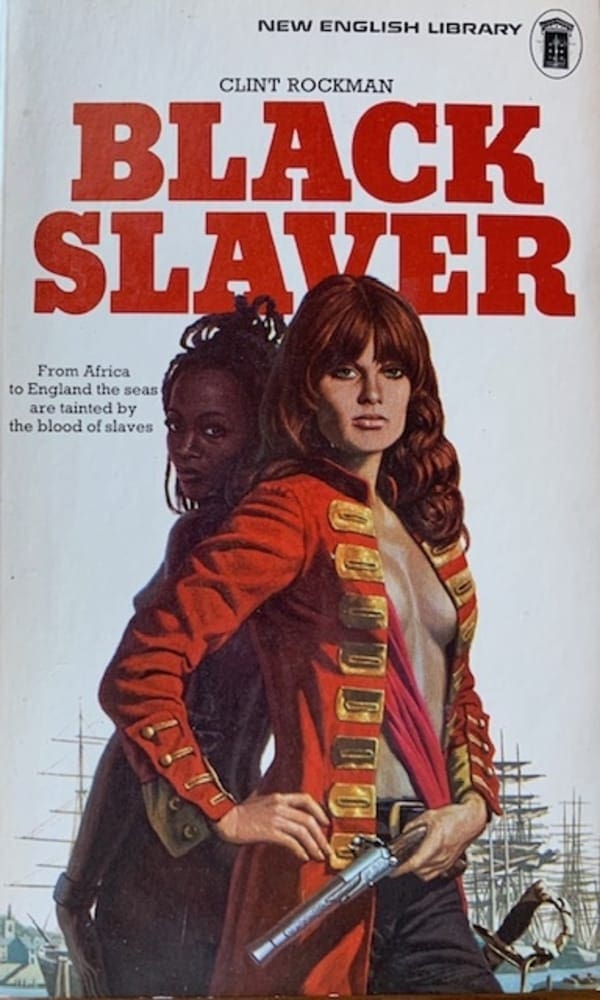TRASHY TUESDAY: Black Slaver by Clint Rockman (New English Library, 1972)
Plantation pulp was a weird, popular sub-genre championed by many publishers in the 1970s (see my earlier post on Chane’s Vengeance by Norman Gant). British publisher New English Library (NEL) was a particularly enthusiastic promoter of plantation novels and between 1968 and 1981 published about 50 slaver novels.
Many of the plantation/slaver novels were imported from the United States, however, NEL also used British writers to meet the demand. One of the authors they turned to was well known science fiction author and general genre handyman Kenneth Bulmer. Between 1972 and 1974 Bulmer churned out 7 slaver/plantation novels under the great nom de plume of Clint Rockman. Black Slaver was the first and probably one of the better ones.
Unlike the standard NEL fare of inter-racial sex and violence on American plantations, Black Slaver was more of a maritime adventure as teenager Richard Luckhurst joins the crew of the slaver Revenge under the command of the gorgeous redhead Emmalena Canyng:
“She wore a plain black-varnished straw tricorne with a gay white plume. It perched atop her mass of reddish blonde hair. She was all woman, all luscious ripeness; yet in the watered-silk sash around her lissom waist were thrust two pistols, and a long knife swung at her side.”
From there it is all action and fun aboard the Revenge as it engages in its unpleasant trade of slaving. Bulmer (Rockman) provides some hollow justification for Canyng’s involvement in the slave trade (she was raped by slaves as a teenager), but not too much attention is paid to the details of the Revenge’s business. Bulmer also tries to offset it by having a large black man, Rafee, as Canyng’s second in command and a mixed-blood slave girl, Sable, as her friend. The racial and ethnic aspects are nowadays disquieting, but the book probably accurately reflects the views of the time (and of the 1970s for that matter). The sex scenes are relatively tame by today’s standards, including one involving the four friends, but would have been far more salacious in the 1970s. There are also some nasty rape scenes. The ending is somewhat abrupt and violent and sets the scene for further books.
Black Slaver is not a great book, but is probably better written than a lot of the plantation/slaver books by NEL. The story flows well, although the ending is handled clumsily, and the book would have been well received by its largely male audience in the 1970s.
The highlight of the book is the terrific eye-catching cover by Richard Clifton-Dey. Clifton-Dey was a prolific, and well regarded, British cover illustrator in the 1970s and 80s and did numerous covers for NEL during this period, including several of the plantation/slaver covers. Black Slaver is probably one of his better ones with its mix of black and white semi-nudity, prominent pistol and sultry promise, all set against a backdrop of sailing ships. Although politically incorrect nowadays, it is a great example of the eye-catching covers of men’s adventure books from the 1970s.
Once thanks to James Doig’s excellent article in The Paperback Fanatic (No. 41) on the 1970s Plantation Pulps of New English Library, which inspired me to explore out this sub-genre.



OMG! I actually read some of those trashy NEL novels (cough) back in the 1970s. I don’t think I’ll revisit, though.;-)
That surprises me! I never read of them, but i do remember the covers! I read an article about them recently and then found a pile in an bookstore in Goulburn, so got them
That surprises me! I never read any of them, although i remember the covers. I recently read an article on them and then found a pile of them at a small second bookshop in the bush! So i thought i would use them
I had an aunt with a second-hand bookshop in Launceston, and read widely (and not always with discriminating taste) until I came to Canberra in 1974. 🙂